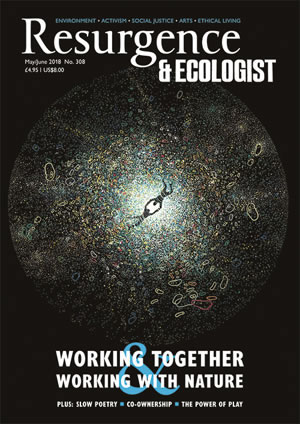God and the secular have been debated in minute detail for centuries, especially since Europe’s 18th-century Enlightenment. To embrace the subject is a huge undertaking, perhaps reminiscent of a statement by Empedocles, Plato, Pascal and Voltaire that God is a “circle whose centre is everywhere and circumference nowhere”.
It is typical of Rupert Sheldrake’s range as a thinker to attempt the task. He adopts a modest, uncontentious style, seeking where science and religion might learn from each other rather than highlighting their manifold divergences. The book is short, and arguably its title draws the circle just too wide to keep its implied promises.
Sheldrake is described by his publishers as being “at the heart of the intellectual and scientific establishment”, which is surely no longer true. He has long been seen as a maverick – even “a heretic”, to use his own epithet. That reputation has stuck with him since he first came up with his theory of morphic resonance and later engaged in a very public dispute with Richard Dawkins, apostle of the selfish gene and former Professor for the Public Understanding of Science at the University of Oxford.
His approach in this book – not the first he has written on overlaps between science and religion – is to identify seven spiritual practices he uses himself and to try, with varying success, to provide scientific evidence for the benefits. The wider aim is to bring together science with a religious, or more precisely Christian, perspective. His strong opposition to the narrowness of scientism and dogmatic materialism, which he argues condemns us to inhabit a lifeless universe, is plain.
Such evidence is very patchy, drawing on a wide range of sciences. They’re often at the ‘softer’ end of the spectrum – psychology or anthropology, say, rather than the traditional terrain of natural science such as physics – and are employed depending on the particular practice. Botany, Sheldrake’s original specialism, figures prominently. At the least convincing end of the scale, he resorts to the health-giving properties of green space and fresh air. Real enough, but some way removed.
Sheldrake starts with meditation, where evidence for the benefits to brain function is relatively abundant, although he is at pains to draw a distinction between the mind’s possibilities and the physical activity of the brain. Meditation has now been widely introduced by corporations and the military, along with groups or individuals more conventionally associated with it.
Moving on to gratitude – not taking people and things for granted, and saying grace before meals – Sheldrake has some pertinent observations. For instance, in a money-based economy, the opposite of gratitude is “a sense of entitlement”, which breeds dissatisfaction and unhappiness. Here the scientific evidence is thin, and much of the chapter resembles good advice from a kindly, civilised uncle.
Then it’s the turn of ‘Reconnecting with the More-Than-Human World’. Clearly, he states, “there is vastly more non-human nature than humanised nature in the universe,” before launching into a discussion of human evolution contrasting the beliefs of traditional societies with modern theories. He works his way up to the Romantic reaction to post-Reformation thought and the 17th-century conviction that Nature is machine-like, unconscious and inanimate, to the revival of animism.
The chapter ends with a slightly startling speculation that the sun may be a conscious entity. Sheldrake cites the ancient belief of many cultures that the sun is a god. (It’s a theory he shares in more recent times with Gurdjieff, who also thought planets were conscious, though the less evolved were somehow parasitic on the energies of the more advanced.)
Later chapters – ‘Relating to Plants’, ‘Rituals and the Presence of the Past’, ‘Singing, Chanting and the Power of Music’, and ‘Pilgrimages and Holy Places’ – display a similar mix of broad understanding and wide knowledge from many fields. The link of each to ‘hard’ scientific evidence remains patchy, though Sheldrake’s naturally speculative cast of mind makes for a continually stimulating journey. Each chapter ends with two suggestions for how readers might put its practice into effect.
I have two main reservations about this book. The first is that it lacks any historical perspective on the immense amount of bloodshed and suffering that religion has engendered in world history and still does. This, too, has formed a major component of religious practice over the centuries, if rather emphatically not the spiritual kind. It is especially true of the three great desert religions – Christianity, Judaism and Islam. Even Buddhists have joined in the slaughter with the recent massacre of the Rohingya people in Myanmar. Perhaps Sheldrake sees this as a perversion of real spiritual belief and practice; others, more sceptical, may wonder why people have created so much suffering in the name of unprovable abstractions or downright illusions. To that question, he offers no answer. It makes it all a bit ‘accentuate the positive’.
The second problem is that where the title implies equal consideration of all spiritual traditions, Christianity comes to predominate progressively as the chapters unfold. Sheldrake was born into a Methodist family, became an atheist early in his science career, and is now a self-declared Anglican, so this may be inevitable.
Where the book leaves a big gap is in its sketchy handling of the non-theistic beliefs and practices of Buddhism, Taoism and Confucianism. For me, Buddhism is a science of mind above all, now converging in revolutionary ways with theoretical physics. The texts of Taoism are also more subtle and mysterious than the sometimes legalistic tone of the Bible. However, Sheldrake can legitimately insist that the prime purpose of his book is to promote practice, so this may well lie beyond its scope.







